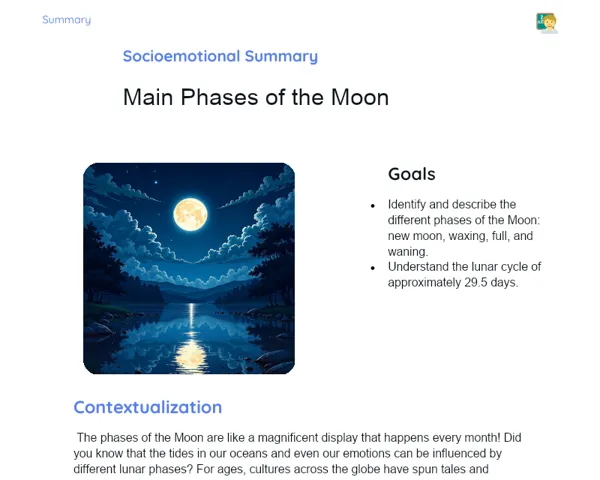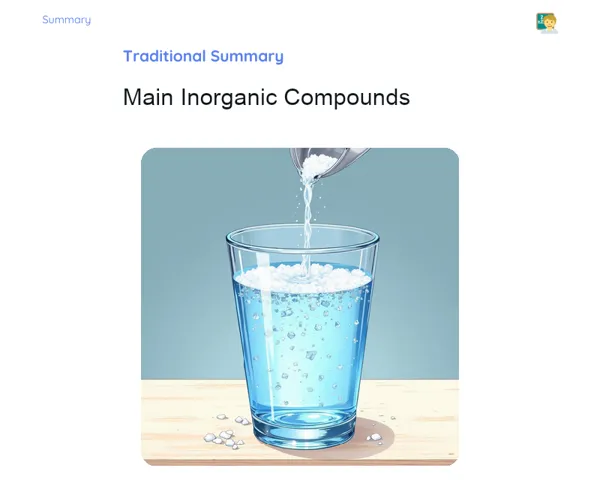Summary Tradisional | Phases of Mixing
Contextualization
In our everyday lives, we constantly encounter various types of mixtures, whether it’s in the kitchen while preparing meals or in nature while appreciating our surroundings. Grasping the concepts of mixtures is crucial not just for scientific understanding but also for many professions and practical scenarios. For instance, seawater is a blend of water and mineral salts, while the air we breathe consists of a mixture of different gases.
Mixtures can generally be categorized into two types: homogeneous and heterogeneous. Homogeneous mixtures are those where the components blend uniformly, resulting in a single visible phase. Common examples include a sugar solution in water and atmospheric air. On the other hand, heterogeneous mixtures are characterized by components that do not blend uniformly, leading to two or more visible phases. Examples are water mixed with oil, granite, and a fruit salad.
To Remember!
Homogeneous Mixtures
Homogeneous mixtures are characterized by components that blend uniformly, creating a single visible phase. This means that even to the naked eye or under a microscope, the different parts of the mixture cannot be distinguished. A classic example is a sugar solution in water, where the sugar dissolves completely, yielding a uniform mixture. Another instance is atmospheric air, which is a combination of several gases, primarily nitrogen and oxygen, appearing as a single gaseous phase.
The key feature of homogeneous mixtures is their uniform properties throughout. This type of mixture is often referred to as a solution. In a solution, the solute (like sugar) dissolves in the solvent (like water) so evenly that there’s no visible separation between the components. This characteristic is vital in industrial and laboratory settings where consistency is paramount.
Additionally, homogeneous mixtures maintain uniform physical properties throughout. For instance, density, solute concentration, and other properties remain constant in any part of the solution. This is in contrast to heterogeneous mixtures, where such properties can vary based on the mixture’s specific location.
The significance of homogeneous mixtures in our daily lives cannot be overstated. From the drinking water we consume to the medicines we rely on, many substances we engage with on a daily basis are homogeneous mixtures. Understanding their behavior and manipulation is crucial across various fields and practices.
-
Homogeneous mixtures exhibit a single visible phase.
-
Components blend uniformly.
-
Examples include sugar solution in water and atmospheric air.
-
Physical and chemical properties are consistent throughout the mixture.
Heterogeneous Mixtures
Heterogeneous mixtures consist of components that do not blend uniformly, leading to two or more visible phases. This means that the different parts of the mixture can be observed clearly, either with the naked eye or under a microscope. Typical examples of heterogeneous mixtures are water and oil, which remain separate and create two distinct layers, and fruit salad, where each fruit piece represents a different phase.
The key characteristic of heterogeneous mixtures is the presence of multiple phases, each possessing unique physical and chemical properties. These phases can be separated using simple physical methods, such as decantation, filtration, or centrifugation. The ability to separate components of a heterogeneous mixture serves utility in many industrial and scientific settings, particularly where the purification of substances is required.
Heterogeneous mixtures may also show considerable variation in properties based on the distribution and quantity of each component. For example, the texture, color, and density can differ in various parts of the sample. This is unlike homogeneous mixtures, which maintain uniform properties.
In our daily lives, heterogeneous mixtures are commonplace and have several practical applications. In cooking, knowing how to separate components can be critical for certain dishes. In industry, separating heterogeneous mixtures plays an essential role in processes like recycling and producing pure chemicals.
-
Heterogeneous mixtures display two or more visible phases.
-
Components do not blend uniformly.
-
Examples include water and oil, fruit salad.
-
Physical and chemical properties change in different parts of the mixture.
Phases of Mixtures
A phase in a mixture refers to a homogeneous portion that stands out physically from other sections. In homogeneous mixtures, only one visible phase is present due to the uniform blending of components. In contrast, heterogeneous mixtures consist of two or more visible phases, each possessing distinct characteristics. For example, in a mixture of water and oil, water constitutes one phase, and oil constitutes another.
Recognizing the phases in a mixture is essential for understanding the properties and behaviors of that mixture. In heterogeneous mixtures, each phase may have varying physical and chemical properties, such as density, color, and melting point. These distinctions enable the separation of phases using physical methods like decantation, filtration, and centrifugation.
In homogeneous mixtures, sorting the phases is less apparent since there is only one visible phase. Yet, grasping that this phase constitutes a homogeneous solution is critical in contexts where homogeneity is required, such as in pharmaceutical production and food and beverage manufacturing.
Analyzing the phases of mixtures is a core competency in diverse scientific and technical fields. For instance, in chemistry, understanding mixtures' phases is vital for substance separation and purification, while in engineering, manipulating mixtures' phases is crucial for processes like distillation and extraction. In biology, knowledge of phases is important for techniques such as cell centrifugation and the separation of cellular components.
-
A phase is a homogeneous part of a mixture.
-
Homogeneous mixtures consist of one visible phase.
-
Heterogeneous mixtures have two or more visible phases.
-
Identifying phases is key for separating and purifying substances.
Importance of Mixtures in Daily Life
Mixtures, whether homogeneous or heterogeneous, are prevalent in various aspects of our lives and have numerous real-world applications. In cooking, for example, the preparation of meals frequently involves creating and adjusting mixtures. Knowledge of whether a mixture is homogeneous or heterogeneous can significantly influence how ingredients are combined and processed.
In the food industry, the uniformity of homogeneous mixtures is paramount to ensure product quality and safety. For instance, processed foods and beverages must maintain a consistent composition so that each item delivers the same taste, texture, and nutritional value. Heterogeneous mixtures also hold their importance, especially in products designed to provide different textures and flavors, such as ice creams combined with fruit pieces or chocolate.
In medicine, a comprehension of mixtures is vital for developing and administering medications. Homogeneous solutions are frequently used to ensure accurate and effective dosages. Additionally, separating heterogeneous mixtures is often essential for purifying the chemical compounds utilized in drug formulation.
Regarding the environment, recognizing and managing mixtures is critical for waste management and conserving natural resources. Recycling, for example, relies on the capability to separate components from heterogeneous mixtures. Furthermore, processes like water purification and effluent treatment often involve the separation of dissolved substances found in homogeneous mixtures.
-
Mixtures are common in cooking and the food industry.
-
Homogeneous mixtures ensure food product consistency.
-
Heterogeneous mixtures are significant for combining different textures and flavors.
-
Understanding mixtures is vital in medicine and waste management.
Key Terms
-
Homogeneous Mixtures: Mixtures where components blend uniformly, forming a single visible phase.
-
Heterogeneous Mixtures: Mixtures where components do not blend uniformly, leading to two or more visible phases.
-
Phase: A homogeneous portion of a mixture, physically distinct from others.
-
Solute: A substance that dissolves in a solvent to create a solution.
-
Solvent: A substance that dissolves the solute to create a solution.
-
Decantation: A method of separating heterogeneous mixtures based on the density difference.
-
Filtration: A process for separating heterogeneous mixtures using a filter to trap solid particles.
-
Centrifugation: A method of separating heterogeneous mixtures using centrifugal force to segregate components of differing densities.
Important Conclusions
In this lesson, we delved into the distinctions between homogeneous and heterogeneous mixtures, recognizing their characteristics and the phases within each type. We learned that homogeneous mixtures showcase a single visible phase with uniformly blended components, while heterogeneous mixtures reveal two or more distinct phases with components that aren’t blended uniformly. Additionally, we emphasized that recognizing these phases is critical for the separation and purification of substances, an essential concept across various domains like cooking, medicine, and environmental science.
The relevance of understanding mixtures and their phases extends to several activities in daily life as well as numerous professions. The uniformity in homogeneous mixtures is crucial for ensuring quality in food and medications, while the separation of components in heterogeneous mixtures plays an essential role in industrial processes and recycling. Therefore, analyzing mixture phases becomes a fundamental skill for addressing practical challenges across various contexts.
We encourage you to keep exploring this subject, as it paves the way for grasping many advanced concepts in science. Understanding mixtures and their phases not only bolsters your scientific insight but also enhances your ability to apply this knowledge practically, making you a valuable asset in various professional fields.
Study Tips
-
Review the instances of homogeneous and heterogeneous mixtures discussed in class and seek out new examples in your daily routine.
-
Practice recognizing and counting phases in various mixtures using techniques like decantation and filtration to visualize separations.
-
Research further on the applications of mixtures in areas of interest such as medicine, food industry, or waste management to better appreciate the practical significance of this knowledge.



